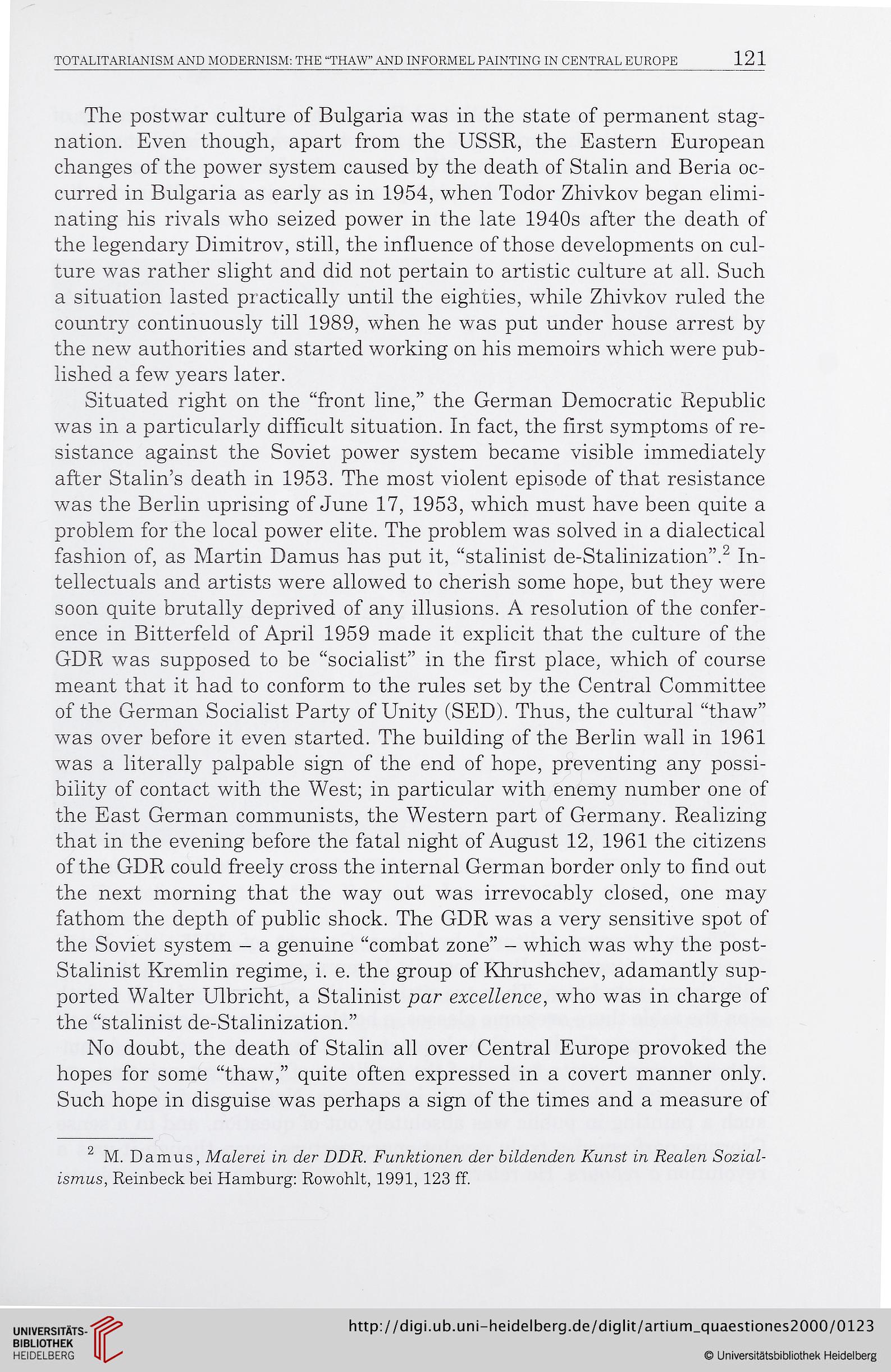TOTALITARIANISM AND MODERNISM: THE “THAW” AND INFORMEL PAINTING IN CENTRAL EUROPE
121
The postwar culture of Bulgaria was in the State of permanent stag-
nation. Even though, apart from the USSR, the Eastern European
changes of the power System caused by the death of Stalin and Beria oc-
curred in Bulgaria as early as in 1954, when Todor Zhivkov began elimi-
nating his rivais who seized power in the late 1940s after the death of
the legendary Dimitrov, still, the influence of those developments on cul-
ture was rather slight and did not pertain to artistic culture at ail. Such
a situation lasted practically until the eighties, while Zhivkov ruled the
country continuously till 1989, when he was put under house arrest by
the new authorities and started working on his memoirs which were pub-
lished a few years later.
Situated right on the “front line,” the German Démocratie Republic
was in a particularly diffïcult situation. In fact, the fïrst symptoms of ré-
sistance against the Soviet power System became visible immediately
after Stalin’s death in 1953. The most violent épisode of that résistance
was the Berlin uprising of June 17, 1953, which must hâve been quite a
problem for the local power elite. The problem was solved in a dialectical
fashion of, as Martin Damus has put it, “stalinist de-Stalinization”.2 * In-
tellectuals and artists were allowed to cherish some hope, but they were
soon quite brutally deprived of any illusions. A resolution of the confér-
ence in Bitterfeld of April 1959 made it explicit that the culture of the
GDR was supposed to be “socialist” in the fïrst place, which of course
meant that it had to conform to the rules set by the Central Committee
of the German Socialist Party of Unity (SED). Thus, the cultural “thaw”
was over before it even started. The building of the Berlin wall in 1961
was a literally palpable sign of the end of hope, preventing any possi-
biiity of contact with the West; in particular with enemy number one of
the East German communists, the Western part of Germany. Realizing
that in the evening before the fatal night of August 12, 1961 the citizens
of the GDR could freely cross the internai German border only to fïnd out
the next morning that the way out was irrevocably closed, one may
fathom the depth of public shock. The GDR was a very sensitive spot of
the Soviet System - a genuine “combat zone” - which was why the post-
Stalinist Kremlin régime, i. e. the group of Khrushchev, adamantly sup-
ported Walter Ulbricht, a Stalinist par excellence, who was in charge of
the “stalinist de-Stalinization.”
No doubt, the death of Stalin ail over Central Europe provoked the
hopes for some “thaw,” quite often expressed in a covert manner only.
Such hope in disguise was perhaps a sign of the times and a measure of
2 M. Damus, Malerei in der DDR. Funktionen der bildenden Kunst in Realen Sozial-
ismus, Reinbeck bei Hamburg: Rowohlt, 1991, 123 ff.
121
The postwar culture of Bulgaria was in the State of permanent stag-
nation. Even though, apart from the USSR, the Eastern European
changes of the power System caused by the death of Stalin and Beria oc-
curred in Bulgaria as early as in 1954, when Todor Zhivkov began elimi-
nating his rivais who seized power in the late 1940s after the death of
the legendary Dimitrov, still, the influence of those developments on cul-
ture was rather slight and did not pertain to artistic culture at ail. Such
a situation lasted practically until the eighties, while Zhivkov ruled the
country continuously till 1989, when he was put under house arrest by
the new authorities and started working on his memoirs which were pub-
lished a few years later.
Situated right on the “front line,” the German Démocratie Republic
was in a particularly diffïcult situation. In fact, the fïrst symptoms of ré-
sistance against the Soviet power System became visible immediately
after Stalin’s death in 1953. The most violent épisode of that résistance
was the Berlin uprising of June 17, 1953, which must hâve been quite a
problem for the local power elite. The problem was solved in a dialectical
fashion of, as Martin Damus has put it, “stalinist de-Stalinization”.2 * In-
tellectuals and artists were allowed to cherish some hope, but they were
soon quite brutally deprived of any illusions. A resolution of the confér-
ence in Bitterfeld of April 1959 made it explicit that the culture of the
GDR was supposed to be “socialist” in the fïrst place, which of course
meant that it had to conform to the rules set by the Central Committee
of the German Socialist Party of Unity (SED). Thus, the cultural “thaw”
was over before it even started. The building of the Berlin wall in 1961
was a literally palpable sign of the end of hope, preventing any possi-
biiity of contact with the West; in particular with enemy number one of
the East German communists, the Western part of Germany. Realizing
that in the evening before the fatal night of August 12, 1961 the citizens
of the GDR could freely cross the internai German border only to fïnd out
the next morning that the way out was irrevocably closed, one may
fathom the depth of public shock. The GDR was a very sensitive spot of
the Soviet System - a genuine “combat zone” - which was why the post-
Stalinist Kremlin régime, i. e. the group of Khrushchev, adamantly sup-
ported Walter Ulbricht, a Stalinist par excellence, who was in charge of
the “stalinist de-Stalinization.”
No doubt, the death of Stalin ail over Central Europe provoked the
hopes for some “thaw,” quite often expressed in a covert manner only.
Such hope in disguise was perhaps a sign of the times and a measure of
2 M. Damus, Malerei in der DDR. Funktionen der bildenden Kunst in Realen Sozial-
ismus, Reinbeck bei Hamburg: Rowohlt, 1991, 123 ff.





